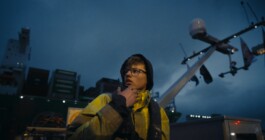
A FILM BY MAX CARLO KOHAL
VRACHT
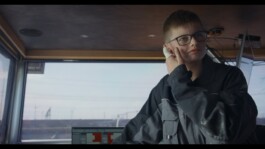
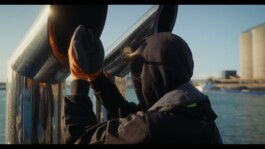
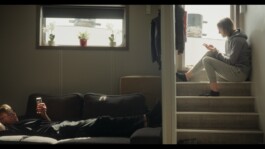
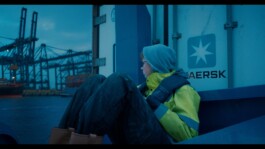
SYNOPSIS
Auf einem Containerschiff träumt der junge Matrose Rudmer davon, eines Tages selbst Kapitän zu werden. Als der Neuankömmling Tycho an Bord kommt, ärgert sich Rudmer über die Faulheit seines Kollegen. Er versucht, Tycho zu motivieren, doch der verlässt das Schiff. Seinen Platz nimmt Leanne ein, zu der Rudmer schnell Vertrauen aufbaut. Doch ihre Nähe währt nur kurz, denn Leanne beschließt, auf ein anderes Schiff zu wechseln.
OFFIZIELLER TRAILER
INTERVIEW
Nils Altland, Medienjournalist beim NDR
und Regisseur Max Carlo Kohal
«VRACHT» gibt einen tiefen Einblick in den Arbeitsalltag auf der Panerai. Was interessiert Dich an der Flussschifffahrt?
Seit ich 2016 nach Basel an den Rhein gezogen bin, hat der Fluss eine besondere Bedeutung für mich. Der Rhein ein Treffpunkt für alle, die hier leben, um sich im Sommer abzukühlen: Man schwimmt stromabwärts an Kähnen vorbei, die einem entgegenkommen. Gleichzeitig sind die Basler Rheinhäfen wichtig für den Schweizer Im- und Export. Ich habe mich immer gefragt, wer die Menschen sind, die auf diesen Schiffen leben, und welche Verbindung ich zu diesem Transportmittel. Wenn ich an Globalisierung denke, denke ich an Lastwagen, Züge und riesige Containerschiffe auf den Weltmeeren, aber ein Teil dieses Warenumschlags scheint direkt vor meiner Haustür stattzufinden, mit Menschen, die im Dienste dieser Logistik stehen. Für mich ist das Leben auf einem Schiff eine Welt, von der ich keine Ahnung hatte, wie sie funktioniert. Ich hatte eine romantische Vorstellung vom Leben auf einem Schiff, das in die Weiten der großen Häfen Europas hinausfährt. Ich verbrachte Stunden in den Häfen von Basel und sah zu, wie Container verladen, Aluminium transportiert und Hunderte von Tonnen Stahlschrott ein- und ausgeladen wurden. Nachdem ich mit meinen Recherchen begonnen hatte, begann die Romantik dieser Welt schnell zu bröckeln. Ich lernte junge Menschen aus verschiedenen Teilen Europas kennen, die den Knochenjob eines Matrosen oder Kapitäns ausüben. Lange Tage und Nächte in Häfen, Be- und Entladen, den Elementen ausgesetzt, Instandhaltung des Schiffes. Besonders fasziniert haben mich die jungen Leute, die im Alter von 15 Jahren ihre Ausbildung auf den Schiffen beginnen. Hätte ich meine Jugend zwei Wochen fern von zu Hause mit fremden Menschen verbringen können? Meine Familie und Freunde zurückzulassen und mein Leben in die Hände eines Kapitäns zu legen, neben dröhnenden Motoren, quietschenden Verladeterminals und tonnenschweren Containern?
Im Zentrum des Films stehen der junge Matrose Rudmer und sein Erwachsenwerden. Wie hast Du ihn gefunden und kennengelernt?
Im Frühjahr 2021 traf ich Rudmer zufällig im Basler Hafenbecken und erzählte ihm von meinem Vorhaben. Nach verzweifelten Versuchen in der Corona-Zeit auf ein Schiff zu gelangen, schien die gerade abfahrende Panerai an einem Freitagnachmittag im Hafenbecken 2 als meine letzte Chance. Rudmer legte gerade die Taue los und Kapitän Martin wollte schon mit heulenden Motoren das Hafenbecken verlassen. Doch die 2 Minuten zwischen der Crew und mir reichten aus um die ersten Recherchedrehtage im Mai 2021 stattfinden zu lassen.
Im Film sieht man Rudmer, Leanne und ihre Kollegen in sichtbaren Schritten älter werden. Wie lange hast Du sie begleitet und was hat Dich daran am meisten fasziniert?
Nach den ersten Drehtagen begleiteten wir die Panerai-Kurse 3 Jahre lang in Folge. Der Grund für die konstante Motivation: Wir wollten sehen, wie sich die Teenager zu jungen Erwachsenen entwickeln. Jedes Mal, wenn wir zurückkamen, reiften sie alle in kleinen sichtbaren Schritten, aber auch auf charakteristische Weise.
Du und Dein Kameramann seid Euren Protagonisten in intimen Momenten ziemlich nahe gekommen. Wie ist Euch das gelungen?
Anfangs war ich besorgt, wie sie sich verhalten würden, wenn ich einen Kameramann mitbringe, aber der intensive Vertrauensaufbau haben uns geholfen diese Nähe natürlich entstehen zu lassen. Wir erklärten ihnen immer, was wir taten, zeigten ihnen das Material, das wir aufgenommen hatten, und schalteten oft einfach die Kameraaus, um die Zeit mit ihnen zu genießen. Wir aßen zusammen, schliefen auf dem Schiff neben ihren Zimmern und diskutierten darüber, was in ihrer und unserer Welt vor sich ging. Bevor wir sie in ihren Zimmern oder Wohnbereichen gefilmt haben, haben wir sie um Erlaubnis gebeten. Wir wollten, dass sie wissen, dass wir ein Abendessen, eine Mittagspause oder etwas anderes als ihre Arbeit filmen würden. Kommunikation über unser Handeln und eine klare Kommunikation wurde zu unserem Modus Operandi und dann konnten wir einfach mit der Kamera auf Momente warten und und wurden so unsichtbar für sie.
In der ersten Szene schneidet sich Rudmer in die Hand. In anderen Szenen erleben wir ihn im Streit mit Kollegen. Ihr wart offenbar in den richtigen Momenten mit der Kamera dabei. Wie viel Glück hattet Ihr bei den Dreharbeiten?
Ich würde nicht sagen, dass wir während der Dreharbeiten Glück hatten - das große Glück bestand darin, diese Crew und diese Gelegenheit zu finden. Dinge wie Streit, Diskussionen oder kleine Unfälle passieren auf allen möglichen Schiffen, aber die Möglichkeit, dort zu sein, mit ihnen zu leben, ihr Vertrauen und ihre Kameradschaft zu genießen, hat diesen Film erst möglich gemacht. Wir hatten das große Glück, ein Unternehmen zu finden, das uns erlaubte, auf der Panerai zu sein, wann immer wir wollten. Natürlich war der Moment, in dem Rudmer sich in den Finger schnitt und die Kamera lief, ein Glücksmoment - aber das eigentliche Glück bestand darin, eine vielfältige Crew zu finden, die bereit war, sich von uns filmen zu lassen und uns einen Einblick in ihr Leben zu geben.
Der DoP Lukas Gut hat imposante Bilder geschaffen. Wie kam es zu dieser Zusammenarbeit und wie lief sie auf der Panerai ab?
Lukas und ich begannen gemeinsam an der Zürcher Hochschule der Künste zu studieren. Wir wurden gute Freunde und arbeiteten gerne bei anderen Projekten zusammen, bevor gemeinsam starteten an VRACHT zu arbeiten. Wir waren beide von der visuellen Gewalt der Häfen begeistert. Ich bin wirklich sehr glücklich, dass er mir bei diesem Film geholfen hat. Ich war oft ratlos, wusste nicht, was ich tun oder drehen sollte, aber Lukas war immer da, drehte einfach weiter, gab mir Raum zum Nachdenken und Reflektieren dessen, was wir taten. Seine ständige Bereitschaft, seine Schwimmweste anzulegen und die Kamera nah an unsere Protagonisten heranzubringen, war neben der Schaffung großartiger Bilder sein großer Beitrag zum Entstehen dieses Dokumentarfilms.
In zwei Einstellungen sieht man eine Kirmes am Ufer. Die schöne, bunte Welt an Land zieht an den Jugendlichen vorbei – erwachsen werden sie an Bord. Hast Du Rudmer oder Leanne auch mal an Land begleitet? Wie ist ihr Leben, wenn sie gerade nicht arbeiten?
Wir blieben eine Woche lang in den Niederlanden und besuchten Daan und Leanne zu Hause. Aber während der Schnittphase wurde schnell deutlich, dass wir uns auf das Leben auf dem Schiff konzentrieren und das Leben an Land hinter uns lassen wollten. Mit diesen Bildern von der Küste wollten wir einen Eindruck davon vermitteln, wie ihr Leben außerhalb des Schiffes aussehen könnte.
«VRACHT» gibt kaum Orientierung anhand von Ort, Zeit oder Fahrtrichtung, nur manchmal erkennt man den Kölner Dom oder man erfährt, in welchem Terminal gerade Container verladen werden. Die Panterai wird zum Mikrokosmos. Wie passt das zu Eurem Erleben auf dem Schiff?
Da sich das Schiff rund um die Uhr bewegt und die Besatzung rund um die Uhr arbeitet, habe ich an den ersten Wochen an Bord das Gefühl für Raum und Zeit verloren. Zwischen Basel und Straßburg gibt es 11 Schleusen, in Antwerpen und Rotterdam ist man in Häfen mit berühmten Schiffen wie der Evergiven, voller Terminals die sich in der Grösse übertrumofen. Es fühlt sich an wie ein ständiges Treiben ohne klares Ziel, wo man inmitten der Natur der Lorelei einschläft und unter einem Containerterminal einer Großstadt aufwacht. Der Film gibt dieses Gefühl des Verlorenseins zwischen den Stationen wieder. Es geht nicht darum wo das Schiff ist sondern wohin die Reise unserer Figuren geht.
Das Duo Roman Stocker und Tania Stöcklin hat den Film geschnitten, was sicher keine leichte Aufgabe war. Was macht ihre Arbeit an dem Film besonders?
Der Schnitt von «VRACHT» hat etwa anderthalb Jahre gedauert. Angefangen mit dem Schnitt hatte Roman, ebenfalls ein Freund aus meinem Studium. Wir begannen mit der Auswahl von über 200 Stunden Filmmaterial. Als Tania (Roman und ich sind große Fans von ihr) zu dem Projekt stieß, wurden wir im Schneideraum ein tolles Team. Tania brachte ihr Fachwissen in die Dramaturgie des Films ein. Wir haben wirklich hart daran gearbeitet, die Charaktere des Films zu formen und dabei so nah wie möglich an der Realität des Lebens von Rudmer und seinen Kameraden zu bleiben. Es erforderte viel Liebe zum Detail, um in der riesigen Menge an Filmmaterial die großen Momente zu finden. Ich bin ihnen sehr dankbar für ihre Beharrlichkeit und dafür, dass sie immer wieder überprüft haben, ob wir in dem ganzen Material etwas übersehen haben. Eine Reise, die ich nie wieder vergessen werde.
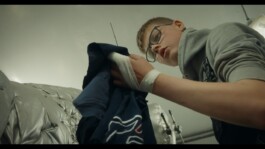
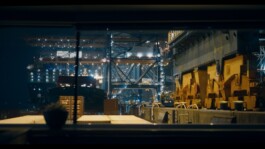
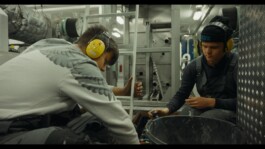
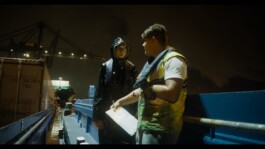
KONTAKT







A FILM BY MAX CARLO KOHAL
VRACHT

SYNOPSIS
Auf einem Containerschiff träumt der junge Matrose Rudmer davon, eines Tages selbst Kapitän zu werden. Als der Neuankömmling Tycho an Bord kommt, ärgert sich Rudmer über die Faulheit seines Kollegen. Er versucht, Tycho zu motivieren, doch der verlässt das Schiff. Seinen Platz nimmt Leanne ein, zu der Rudmer schnell Vertrauen aufbaut. Doch ihre Nähe währt nur kurz, denn Leanne beschließt, auf ein anderes Schiff zu wechseln.


INTERVIEW
Nils Altland, media journalist at NDR
questions Max Carlo Kohal
«VRACHT» gibt einen tiefen Einblick in den Arbeitsalltag auf der Panerai. Was interessiert Dich an der Flussschifffahrt?
Seit ich 2016 nach Basel an den Rhein gezogen bin, hat der Fluss eine besondere Bedeutung für mich. Der Rhein ein Treffpunkt für alle, die hier leben, um sich im Sommer abzukühlen: Man schwimmt stromabwärts an Kähnen vorbei, die einem entgegenkommen. Gleichzeitig sind die Basler Rheinhäfen wichtig für den Schweizer Im- und Export. Ich habe mich immer gefragt, wer die Menschen sind, die auf diesen Schiffen leben, und welche Verbindung ich zu diesem Transportmittel. Wenn ich an Globalisierung denke, denke ich an Lastwagen, Züge und riesige Containerschiffe auf den Weltmeeren, aber ein Teil dieses Warenumschlags scheint direkt vor meiner Haustür stattzufinden, mit Menschen, die im Dienste dieser Logistik stehen. Für mich ist das Leben auf einem Schiff eine Welt, von der ich keine Ahnung hatte, wie sie funktioniert. Ich hatte eine romantische Vorstellung vom Leben auf einem Schiff, das in die Weiten der großen Häfen Europas hinausfährt. Ich verbrachte Stunden in den Häfen von Basel und sah zu, wie Container verladen, Aluminium transportiert und Hunderte von Tonnen Stahlschrott ein- und ausgeladen wurden. Nachdem ich mit meinen Recherchen begonnen hatte, begann die Romantik dieser Welt schnell zu bröckeln. Ich lernte junge Menschen aus verschiedenen Teilen Europas kennen, die den Knochenjob eines Matrosen oder Kapitäns ausüben. Lange Tage und Nächte in Häfen, Be- und Entladen, den Elementen ausgesetzt, Instandhaltung des Schiffes. Besonders fasziniert haben mich die jungen Leute, die im Alter von 15 Jahren ihre Ausbildung auf den Schiffen beginnen. Hätte ich meine Jugend zwei Wochen fern von zu Hause mit fremden Menschen verbringen können? Meine Familie und Freunde zurückzulassen und mein Leben in die Hände eines Kapitäns zu legen, neben dröhnenden Motoren, quietschenden Verladeterminals und tonnenschweren Containern?
Im Zentrum des Films stehen der junge Matrose Rudmer und sein Erwachsenwerden. Wie hast Du ihn gefunden und kennengelernt?
Im Frühjahr 2021 traf ich Rudmer zufällig im Basler Hafenbecken und erzählte ihm von meinem Vorhaben. Nach verzweifelten Versuchen in der Corona-Zeit auf ein Schiff zu gelangen, schien die gerade abfahrende Panerai an einem Freitagnachmittag im Hafenbecken 2 als meine letzte Chance. Rudmer legte gerade die Taue los und Kapitän Martin wollte schon mit heulenden Motoren das Hafenbecken verlassen. Doch die 2 Minuten zwischen der Crew und mir reichten aus um die ersten Recherchedrehtage im Mai 2021 stattfinden zu lassen.
Im Film sieht man Rudmer, Leanne und ihre Kollegen in sichtbaren Schritten älter werden. Wie lange hast Du sie begleitet und was hat Dich daran am meisten fasziniert?
Nach den ersten Drehtagen begleiteten wir die Panerai-Kurse 3 Jahre lang in Folge. Der Grund für die konstante Motivation: Wir wollten sehen, wie sich die Teenager zu jungen Erwachsenen entwickeln. Jedes Mal, wenn wir zurückkamen, reiften sie alle in kleinen sichtbaren Schritten, aber auch auf charakteristische Weise.
Du und Dein Kameramann seid Euren Protagonisten in intimen Momenten ziemlich nahe gekommen. Wie ist Euch das gelungen?
Anfangs war ich besorgt, wie sie sich verhalten würden, wenn ich einen Kameramann mitbringe, aber der intensive Vertrauensaufbau haben uns geholfen diese Nähe natürlich entstehen zu lassen. Wir erklärten ihnen immer, was wir taten, zeigten ihnen das Material, das wir aufgenommen hatten, und schalteten oft einfach die Kameraaus, um die Zeit mit ihnen zu genießen. Wir aßen zusammen, schliefen auf dem Schiff neben ihren Zimmern und diskutierten darüber, was in ihrer und unserer Welt vor sich ging. Bevor wir sie in ihren Zimmern oder Wohnbereichen gefilmt haben, haben wir sie um Erlaubnis gebeten. Wir wollten, dass sie wissen, dass wir ein Abendessen, eine Mittagspause oder etwas anderes als ihre Arbeit filmen würden. Kommunikation über unser Handeln und eine klare Kommunikation wurde zu unserem Modus Operandi und dann konnten wir einfach mit der Kamera auf Momente warten und und wurden so unsichtbar für sie.
In der ersten Szene schneidet sich Rudmer in die Hand. In anderen Szenen erleben wir ihn im Streit mit Kollegen. Ihr wart offenbar in den richtigen Momenten mit der Kamera dabei. Wie viel Glück hattet Ihr bei den Dreharbeiten?
Ich würde nicht sagen, dass wir während der Dreharbeiten Glück hatten - das große Glück bestand darin, diese Crew und diese Gelegenheit zu finden. Dinge wie Streit, Diskussionen oder kleine Unfälle passieren auf allen möglichen Schiffen, aber die Möglichkeit, dort zu sein, mit ihnen zu leben, ihr Vertrauen und ihre Kameradschaft zu genießen, hat diesen Film erst möglich gemacht. Wir hatten das große Glück, ein Unternehmen zu finden, das uns erlaubte, auf der Panerai zu sein, wann immer wir wollten. Natürlich war der Moment, in dem Rudmer sich in den Finger schnitt und die Kamera lief, ein Glücksmoment - aber das eigentliche Glück bestand darin, eine vielfältige Crew zu finden, die bereit war, sich von uns filmen zu lassen und uns einen Einblick in ihr Leben zu geben.
Der DoP Lukas Gut hat imposante Bilder geschaffen. Wie kam es zu dieser Zusammenarbeit und wie lief sie auf der Panerai ab?
Lukas und ich begannen gemeinsam an der Zürcher Hochschule der Künste zu studieren. Wir wurden gute Freunde und arbeiteten gerne bei anderen Projekten zusammen, bevor gemeinsam starteten an VRACHT zu arbeiten. Wir waren beide von der visuellen Gewalt der Häfen begeistert. Ich bin wirklich sehr glücklich, dass er mir bei diesem Film geholfen hat. Ich war oft ratlos, wusste nicht, was ich tun oder drehen sollte, aber Lukas war immer da, drehte einfach weiter, gab mir Raum zum Nachdenken und Reflektieren dessen, was wir taten. Seine ständige Bereitschaft, seine Schwimmweste anzulegen und die Kamera nah an unsere Protagonisten heranzubringen, war neben der Schaffung großartiger Bilder sein großer Beitrag zum Entstehen dieses Dokumentarfilms.
In zwei Einstellungen sieht man eine Kirmes am Ufer. Die schöne, bunte Welt an Land zieht an den Jugendlichen vorbei – erwachsen werden sie an Bord. Hast Du Rudmer oder Leanne auch mal an Land begleitet? Wie ist ihr Leben, wenn sie gerade nicht arbeiten?
Wir blieben eine Woche lang in den Niederlanden und besuchten Daan und Leanne zu Hause. Aber während der Schnittphase wurde schnell deutlich, dass wir uns auf das Leben auf dem Schiff konzentrieren und das Leben an Land hinter uns lassen wollten. Mit diesen Bildern von der Küste wollten wir einen Eindruck davon vermitteln, wie ihr Leben außerhalb des Schiffes aussehen könnte.
«VRACHT» gibt kaum Orientierung anhand von Ort, Zeit oder Fahrtrichtung, nur manchmal erkennt man den Kölner Dom oder man erfährt, in welchem Terminal gerade Container verladen werden. Die Panterai wird zum Mikrokosmos. Wie passt das zu Eurem Erleben auf dem Schiff?
Da sich das Schiff rund um die Uhr bewegt und die Besatzung rund um die Uhr arbeitet, habe ich an den ersten Wochen an Bord das Gefühl für Raum und Zeit verloren. Zwischen Basel und Straßburg gibt es 11 Schleusen, in Antwerpen und Rotterdam ist man in Häfen mit berühmten Schiffen wie der Evergiven, voller Terminals die sich in der Grösse übertrumofen. Es fühlt sich an wie ein ständiges Treiben ohne klares Ziel, wo man inmitten der Natur der Lorelei einschläft und unter einem Containerterminal einer Großstadt aufwacht. Der Film gibt dieses Gefühl des Verlorenseins zwischen den Stationen wieder. Es geht nicht darum wo das Schiff ist sondern wohin die Reise unserer Figuren geht.
Das Duo Roman Stocker und Tania Stöcklin hat den Film geschnitten, was sicher keine leichte Aufgabe war. Was macht ihre Arbeit an dem Film besonders?
Der Schnitt von «VRACHT» hat etwa anderthalb Jahre gedauert. Angefangen mit dem Schnitt hatte Roman, ebenfalls ein Freund aus meinem Studium. Wir begannen mit der Auswahl von über 200 Stunden Filmmaterial. Als Tania (Roman und ich sind große Fans von ihr) zu dem Projekt stieß, wurden wir im Schneideraum ein tolles Team. Tania brachte ihr Fachwissen in die Dramaturgie des Films ein. Wir haben wirklich hart daran gearbeitet, die Charaktere des Films zu formen und dabei so nah wie möglich an der Realität des Lebens von Rudmer und seinen Kameraden zu bleiben. Es erforderte viel Liebe zum Detail, um in der riesigen Menge an Filmmaterial die großen Momente zu finden. Ich bin ihnen sehr dankbar für ihre Beharrlichkeit und dafür, dass sie immer wieder überprüft haben, ob wir in dem ganzen Material etwas übersehen haben. Eine Reise, die ich nie wieder vergessen werde.


KONTAKT
Dynamic Frame GmbH
Binzstrasse 29
8045 Zürich
info@dynamic-frame.ch
www.dynamic-frame.ch
Max Carlo Kohal
Im Westfeld 8
4055 Basel
mail@maxcarlokohal.com
www.maxcarlokohal.com





